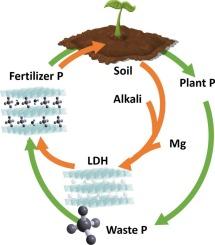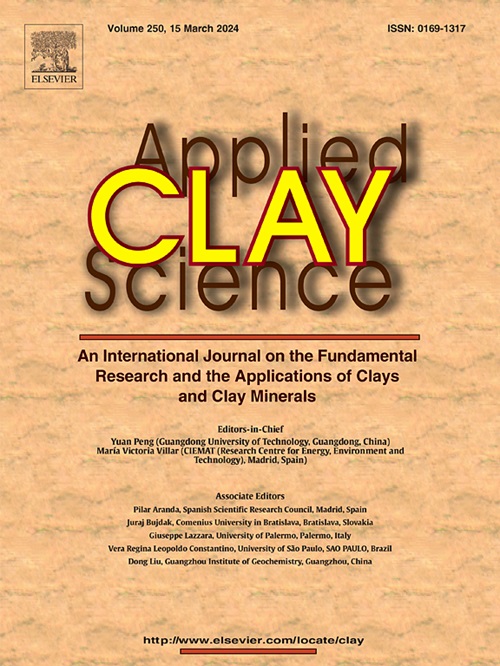One-pot synthesis of MgAl layered double hydroxides (LDH) from weathered tropical soils
IF 5.3
2区 地球科学
Q2 CHEMISTRY, PHYSICAL
引用次数: 0
Abstract
Nutrient recycling is imperative for moving towards a circular economy. Layered double hydroxides (LDH) have been suggested as materials of interest for phosphorus (P) recycling, as they can selectively recover P from liquid waste streams and can be used as efficient P fertilisers in agriculture. Local P recycling with LDH can be particularly valuable for smallholder farmers with limited access to fertilisers, e.g. in tropical regions. However, conventional LDH production relies on external sources of Al3+ for the synthesis of Mg![]() Al LDH. The present work proposed a new fertiliser technology based on LDH partly synthesized at room temperature with weathered soil as a local and omnipresent source of Al, supplemented with MgO and NaOH. The successful synthesis of LDH via this approach was confirmed by X-ray diffractometry (XRD). The capacity of this LDH to recover P was determined with synthetic P solutions and human urine as a waste model. A chemical desorption test demonstrated the available nature of P sorbed onto the soil-based LDH, which largely outperformed the availability of P sorbed onto the untreated soil. Finally, the fertiliser potential of the soil-based LDH loaded with recycled P was confirmed in a pot trial with rice (Oryza sativa L.) in weathered soil, indicating the combined P fertiliser and liming effect. Taken together, this study presented the proof-of-concept of a novel technology for local P recycling in tropical regions.
Al LDH. The present work proposed a new fertiliser technology based on LDH partly synthesized at room temperature with weathered soil as a local and omnipresent source of Al, supplemented with MgO and NaOH. The successful synthesis of LDH via this approach was confirmed by X-ray diffractometry (XRD). The capacity of this LDH to recover P was determined with synthetic P solutions and human urine as a waste model. A chemical desorption test demonstrated the available nature of P sorbed onto the soil-based LDH, which largely outperformed the availability of P sorbed onto the untreated soil. Finally, the fertiliser potential of the soil-based LDH loaded with recycled P was confirmed in a pot trial with rice (Oryza sativa L.) in weathered soil, indicating the combined P fertiliser and liming effect. Taken together, this study presented the proof-of-concept of a novel technology for local P recycling in tropical regions.

从热带风化土壤中一次合成 MgAl 层状双氢氧化物 (LDH)
要实现循环经济,养分循环利用势在必行。有人建议将层状双氢氧化物(LDH)作为磷(P)回收的相关材料,因为它们可以选择性地从液体废物流中回收 P,并可用作农业中的高效 P 肥料。使用 LDH 在当地进行磷回收,对于热带地区等肥料获取途径有限的小农特别有价值。然而,传统的 LDH 生产依赖外部 Al3+ 来合成 MgAl LDH。本研究提出了一种新的肥料技术,该技术以风化土壤为当地无处不在的 Al 源,辅以氧化镁和 NaOH,在室温下合成部分 LDH。X 射线衍射仪 (XRD) 证实,通过这种方法成功合成了 LDH。这种 LDH 回收 P 的能力是用合成 P 溶液和人尿作为废物模型来测定的。化学解吸试验证明了吸附在土壤 LDH 上的 P 的可用性,其可用性大大超过了吸附在未处理土壤上的 P 的可用性。最后,在对风化土壤中的水稻(Oryza sativa L.)进行的盆栽试验中,证实了含有回收钾的土基 LDH 的肥料潜力,表明其具有钾肥和石灰化的综合效果。综上所述,本研究提出了一种在热带地区进行本地钾回收利用的新型技术的概念验证。
本文章由计算机程序翻译,如有差异,请以英文原文为准。
求助全文
约1分钟内获得全文
求助全文
来源期刊

Applied Clay Science
地学-矿物学
CiteScore
10.30
自引率
10.70%
发文量
289
审稿时长
39 days
期刊介绍:
Applied Clay Science aims to be an international journal attracting high quality scientific papers on clays and clay minerals, including research papers, reviews, and technical notes. The journal covers typical subjects of Fundamental and Applied Clay Science such as:
• Synthesis and purification
• Structural, crystallographic and mineralogical properties of clays and clay minerals
• Thermal properties of clays and clay minerals
• Physico-chemical properties including i) surface and interface properties; ii) thermodynamic properties; iii) mechanical properties
• Interaction with water, with polar and apolar molecules
• Colloidal properties and rheology
• Adsorption, Intercalation, Ionic exchange
• Genesis and deposits of clay minerals
• Geology and geochemistry of clays
• Modification of clays and clay minerals properties by thermal and physical treatments
• Modification by chemical treatments with organic and inorganic molecules(organoclays, pillared clays)
• Modification by biological microorganisms. etc...
 求助内容:
求助内容: 应助结果提醒方式:
应助结果提醒方式:


